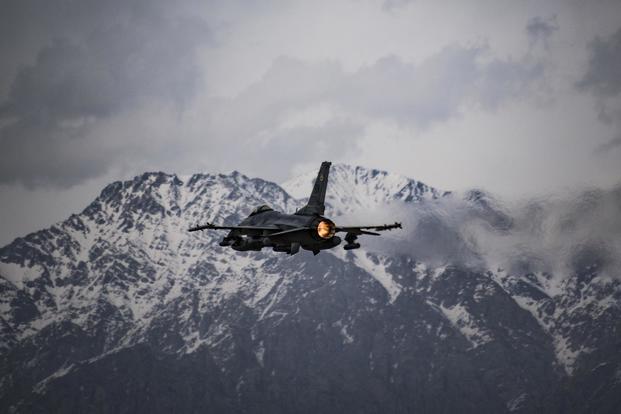U.S. airstrikes in Afghanistan have reached a new record for this year, marking the highest number of airstrikes in Operation Freedom's Sentinel for any month since October.
Fighter, attack and remotely piloted aircraft together dropped nearly 600 weapons in the month of May, according to the recent strike report from Air Forces Central Command. And more bombs were dropped over the 61 days of April and May than over the entirety of 2015, the data shows.
"U.S. air operations in May put tremendous pressure on every branch of the Taliban's network," said Lt. Gen. Jeffrey Harrigian, combined force air component commander and the commander of AFCENT.
Related content:
- Afghan A-29 Drops First Laser-Guided Bomb on Taliban
- General: US Moving More Airpower to Afghanistan in Strategy Shift
"We struck Taliban leadership with precision strikes, and consistently pummeled their revenue-producing facilities, weapons caches and staging facilities," Harrigian said in a release Monday.
Overall, U.S. aircraft flew 726 sorties in Afghanistan last month, with 73 of those sorties including at least one weapon release, AFCENT said.
Airstrikes have been on the rise and will continue to increase in frequency, Operations Freedom's Sentinel and Resolute Support leaders have said in recent months.
For example, more than 4,360 weapons were dropped in the country over 2017, up from 1,330 the previous year.
"We've used airpower -- dropped more munitions this year than any year since 2012," commander of U.S. forces in Afghanistan Gen. John Nicholson said in November.
President Donald Trump last year announced the U.S. would begin sending more troops to Afghanistan to step up the fight against the Taliban and the Afghan offshoot of the Islamic State of Iraq and Syria, called Islamic State-Khorasan province, or ISIS-K.
Since then, the U.S. has stationed a squadron of A-10C Thunderbolt II ground attack aircraft, MQ-9 Reapers for intelligence, surveillance and reconnaissance, along with HH-60G Pave Hawk helicopters for personnel recovery and search and rescue at Kandahar Airfield.
The aircraft in January joined F-16 Fighting Falcon fighter jets, C-130J Hercules mobility airlift, EC-130H Compass Call electronic attack aircraft and other planes supporting these operations from Bagram Airfield.
Meanwhile, mobility missions have also been on the rise, AFCENT said.
C-130 and C-17 Globemaster III planes airdropped more than 190,000 pounds of equipment and supplies in support of U.S. and Afghan ground forces, officials said in the release.
Last month, a C-17 cargo airlifter, based out of Al Udeid Air Base, Qatar, made its first combat airdrop over Southern Afghanistan for the first time in nearly a year and a half.
"Airmen will continue delivering airpower, developing relationships and working closely with our joint partners and the Afghan National Defense and Security Forces to continue setting the conditions in Afghanistan to bring the Taliban to into negotiations with the Afghan government," Harrigian said.
-- Oriana Pawlyk can be reached at oriana.pawlyk@military.com. Follow her on Twitter at @oriana0214.










